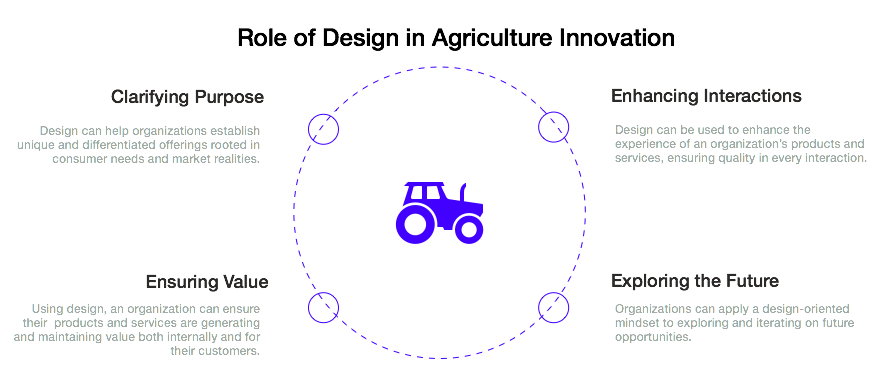-
-
-
-
URL copied!
Rapidly advancing technology and an increased rate of global convergence have transformed how the world produces and consumes products and services — agriculture is no exception. In addition to contending with new economies of scale, today the agriculture industry faces a slew of variable pressures stemming from radical changes in climate and population density.
As companies in the agriculture space turn to innovation to contend with these changes, design can play a fundamental role in helping transform their ideas into reality.
Role of Design in Agriculture Innovation
As an industry rooted in traditional practices and perceptions reaches a point of inflection, agriculture must contend with major shifts in who it serves, what it offers and how it operates.

Who it serves
With increases in health awareness and the growth of sustainable consumption practices, consumers have taken a more active role in shaping food standards, shifting the role of consumer preference from passive to active.
Not only has an increase in visibility and awareness transformed the types of food consumers want, it has also created new opportunities for organizations to design visible and democratized processes around how these foods are grown, sourced and purchased.
What it offers
Traditionally beginning with farming inputs and ending with consumer consumption, companies at the start of agriculture’s value chain have begun to repurpose and re-introduce what was once considered waste.
As organizations continue to imagine new purposes and applications of waste, they will also need to imagine new internal processes and skills to support and advance these new streams of revenue. Through organizational design, companies can ensure their internal value chains meet all the demands of new external ones.
How it operates
As the operations of agriculture companies continue to scale in order to meet the pace of increased demand and technological innovation, the industry’s leading players will need to establish partnerships with organizations and services that were once considered outside the industry’s purview.
As large agriculture companies look to partnerships and acquisitions to expand their existing capabilities, they will need to not only consider the present demands of their industry, but also those of the future. Through design thinking, organizations can push their explorations further, enabling them to uncover opportunities in even the most unlikely of places.
Top Insights
Innovators and Laggards: The Technology Landscape of 2019
Digital TransformationPerspectiveAutomotiveCommunicationsConsumer and RetailFinancial ServicesHealthcareManufacturing and IndustrialMediaTechnologyTop Authors
Blog Categories

Let’s Work Together
Related Content
Unlock the Power of the Intelligent Healthcare Ecosystem
Welcome to the future of healthcare The healthcare industry is on the cusp of a revolutionary transformation. As we move beyond digital connectivity and data integration, the next decade will be defined by the emergence of the Intelligent Healthcare Ecosystem. This is more than a technological shift—it's a fundamental change in how we deliver, experience, … Continue reading Design Innovation in Agriculture →
Learn more
Leveraging SaMD Applications to Improve Patient Care and Reduce Costs
One of the most exciting developments in healthcare is the emergence of Software as a Medical Device (SaMD) as a more convenient and cost-effective means to deliver superior care to the tens of millions of people worldwide who suffer from various health conditions.
Learn more
Share this page:
-
-
-
-
URL copied!